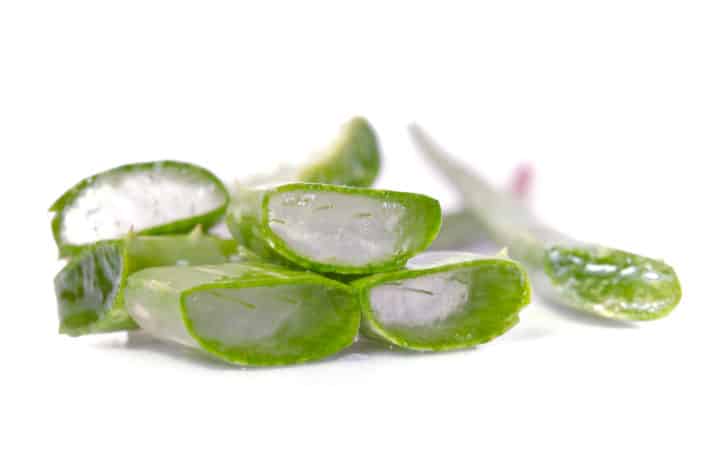Aloin (Barbaloin)
Aloin (barbaloin) is a glycosidic substance from the group of 1,8-dihydrohxyanthracenes. As a natural substance, aloin was first isolated from the Barbados aloe in 1851. It is now known that the substance occurs in more than 20 aloe species as well as in American aloe bark. Depending on the aloe species and origin, the content varies between 5.0 and 40.0 percent. Aloin (barbaloin) has a bitter taste and is found deep inside the plant. The substance is used to ward off predators and protects the plant from rodent infestation.
The dangers of aloin (barbaloin)
The anthranoid aloin (barbaloin) is a powerful laxative that was used as such 2000 years ago. Today, the substance is not desirable in food or cosmetic products due to various side effects. In fact, an overdose can lead to severe symptoms of poisoning with diarrhea and cramping pain, and life-threatening electrolyte and water losses cannot be ruled out as a consequence. Other side effects include disturbances in water and electrolyte balance and kidney inflammation.
And not only that: in 2013, a two-year program of the National Institutes of Health (USA) demonstrated the carcinogenic effect of a whole leaf extract of aloe vera in rats. The WHO’s International Agency for Research on Cancer therefore also classifies whole leaf extracts of aloe vera as “possibly carcinogenic to humans.”
Aloe vera and its use
The Egyptian queens Nefertiti and Cleopatra relied on the power of aloe vera for their beauty care, and scientists have also found drawings of the plant in numerous tombs of the pharaohs.
Today, two Aloe species in particular are used commercially. The first is Aloe barbadensis Miller, which was initially named after the Swedish natural scientist Carl von Linné and was called Aloe vera (Linné), but was later given its current name by the taxonomist Miller. The second species is Aloe aborenscens. The plants belong to the Liliaceae family and originated in East Africa, today they are mainly cultivated on the border between the USA and Mexico.
Basically, two raw materials can be obtained from the leaves of Aloe vera. Just below the skin is a yellowish latex-like sap whose main ingredient is aloin (barbaloin). The thick-fleshed leaves are pressed into juice either whole or peeled. On the other hand, the well-known aloe vera gel can be obtained from the water-rich interior of the leaves. Bitter and laxative substances such as aloin (barbaloin) must be carefully separated during this process. However, if the separation is not 100 percent clean, contamination with the hydroxyanthraquinones can occur, which are considered harmful to health. The European Food Safety Authority (EFSA) has already concluded that some hydroxyanthracene derivatives could damage human DNA.
Aloe vera gel has played an important role in cosmetics, as well as in folk medicine, for quite some time. Anti-inflammatory, immune-stimulating and wound-healing properties are attributed to the gel. Aloin (barbaloin) must not be contained in aloe vera gel. The aim is to achieve a content of less than 5 ppm, but this has not yet been possible in all products. Aloin (barbaloin) contents of less than 20 ppm can only be achieved in aloe vera gels by very complex manual filleting of the plant leaves.
Since whole aloe leaves are frequently offered in the retail trade, the self-preparation of aloe vera gel has recently become increasingly popular. However, this is generally not advisable. As extensive tests have shown, even if the preparation instructions are carefully followed, smaller components of the latex layer and thus also aloin (barbaloin) components can be transferred to the gel. When the sheets are cut, the aloin (barbaloin) contained in the outer layer is almost automatically distributed over the cut surfaces of the gel. However, it cannot usually be sufficiently removed by simply rinsing with water.
Aloin (barbaloin) in cosmetic products
Shower gels, creams, lotions: Aloe vera products are widely used on the German market because the gel has a moisturizing and cooling effect. It also promotes faster tissue regeneration, helps against skin irritations and relieves the symptoms of sunburn, burns and burn injuries.
The plant contains numerous enzymes, vitamins, trace elements and minerals, including iron, calcium and magnesium.
However, the German Federal Institute for Risk Assessment (BfR) recommended some time ago that juices, dietary supplements and other foods made from whole, unpeeled leaves should be avoided. Cosmetics containing gel made from the inner leaf layer have not (yet) been censured by the BfR warning. As a rule, they do not contain whole leaves and therefore no aloin (barbaloin).
Uncertainties remain, however, and the European Food Safety Authority (EFSA) also advises caution.
Fact Sheet Aloin
CAS number: 1415-73-2
Alternative names: aloin, barbaloin, 1,8-dihydroxy-3-hydroxymethyl-10RS-(?)-D-(glucopyranosyl)anthrone.
Definition: the brownish to yellowish leaf resin of the aloe plant
Description: has a bitter taste, smells slightly of aloe
Occurrence: in more than 20 Aloe species
Effect: strongly laxative, potentially carcinogenic and DNA damaging, antimicrobial, antioxidant, anti-inflammatory
Better to use cosmetics without aloin (barbaloin)
Aloe vera has come under criticism thanks to its bitter ingredient aloin (barbaloin): and quite rightly so. The substance not only has a strong laxative effect, but is also suspected of being responsible for various cancers and damaging genetic material. And even though cosmetic products containing aloe vera are usually supposed to be free of aloin (barbaloin), certain doubts remain. Consumers are therefore well advised to use high-quality cosmetics that are guaranteed to be free of aloin (barbaloin). Cosmacon develops sophisticated formulations for your target group that are completely harmless to health.
Sources:
Clear evidence of carcinogenic activity by a whole-leaf extract of Aloe barbadensis miller (aloe vera) in F344/N rats.; Toxicol Sci. 2013 Jan; 131(1):26-39.
Aloe vera at the frontier of glycobiology and integrative medicine: Health implications of an ancient plant.; SAGE Open Med. 2019 Sep 13;7:2050312119875921.
